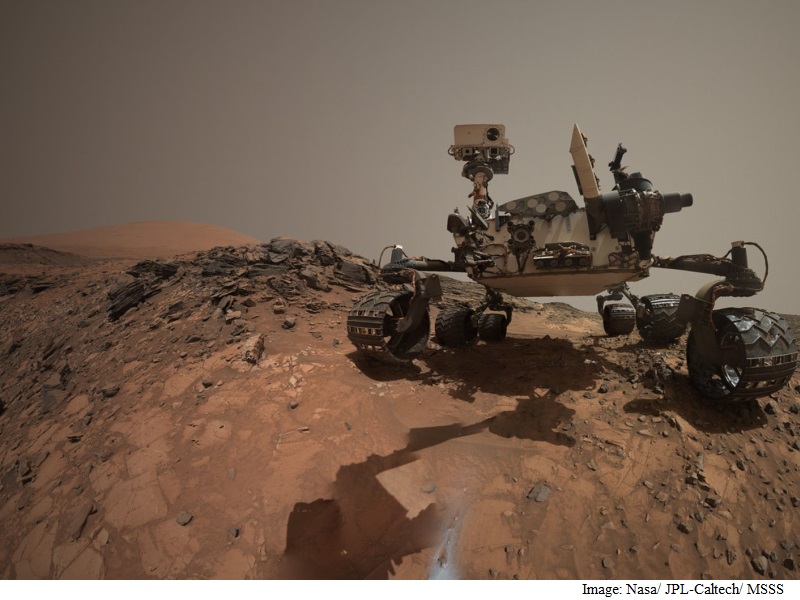- Home
- Science
- Science News
- After Finding Water, Nasa's Mars Rover Scouts New Location
After Finding Water, Nasa's Mars Rover Scouts New Location

The hydrogen indicates that the area was once brimming with water. Hydrogen in the ground beneath the rover is monitored by the rover's Dynamic Albedo of Neutrons (DAN) instrument.
"The ground about one-metre beneath the rover in this area holds three or four times as much water as the ground anywhere else Curiosity has driven during its three years on Mars," said DAN principal investigator Igor Mitrofanov from Space Research Institute in Moscow.
DAN first detected the unexpectedly high level of hydrogen using its passive mode.
Later, the rover drove back over the area using DAN in active mode. The measurements confirmed hydrated material covered by a thin layer of drier material.
In the "Marias Pass" region, Curiosity successfully used its drill to sample a rock target called "Buckskin" and then used the camera on its robotic arm for multiple images to be stitched into a self-portrait at the drilling site.
Curiosity is carrying with it some of the sample powder drilled from "Buckskin".
Silica is a rock-forming chemical containing silicon and oxygen, commonly found on Earth as quartz.
Hydrogen has been detected at low levels everywhere Curiosity has driven and is interpreted as the hydrogen in water molecules or hydroxyl ions bound within or absorbed onto minerals in the rocks and soil.
Curiosity initially noted the area with high silica and hydrogen on May 21 while climbing to a site where two types of sedimentary bedrock lie in contact with each other.
Such contact zones can hold clues about ancient changes in environment, from conditions that produced the older rock type to conditions that produced the younger one.
Curiosity reached the base of "Mount Sharp" region after two years of fruitfully investigating outcrops closer to its landing site and trekking to the mountain.
The main objective now is to examine layers of lower "Mount Sharp" for ancient habitable environments and evidence about how early Mars environments evolved from wetter to drier conditions.
Get your daily dose of tech news, reviews, and insights, in under 80 characters on Gadgets 360 Turbo. Connect with fellow tech lovers on our Forum. Follow us on X, Facebook, WhatsApp, Threads and Google News for instant updates. Catch all the action on our YouTube channel.
Related Stories
- Samsung Galaxy Unpacked 2025
- ChatGPT
- Redmi Note 14 Pro+
- iPhone 16
- Apple Vision Pro
- Oneplus 12
- OnePlus Nord CE 3 Lite 5G
- iPhone 13
- Xiaomi 14 Pro
- Oppo Find N3
- Tecno Spark Go (2023)
- Realme V30
- Best Phones Under 25000
- Samsung Galaxy S24 Series
- Cryptocurrency
- iQoo 12
- Samsung Galaxy S24 Ultra
- Giottus
- Samsung Galaxy Z Flip 5
- Apple 'Scary Fast'
- Housefull 5
- GoPro Hero 12 Black Review
- Invincible Season 2
- JioGlass
- HD Ready TV
- Laptop Under 50000
- Smartwatch Under 10000
- Latest Mobile Phones
- Compare Phones
- Realme P4x 5G
- OnePlus Ace 6T
- OPPO A6x 5G
- Samsung Galaxy Z TriFold
- Poco F8 Ultra
- Poco F8 Pro
- Huawei Mate 80 RS Master Edition
- Huawei Mate 80 Pro Max
- Asus ProArt P16
- MacBook Pro 14-inch (M5, 2025)
- Poco Pad M1
- Poco Pad X1
- Just Corseca Skywatch Pro
- Honor Watch X5
- Acerpure Nitro Z Series 100-inch QLED TV
- Samsung 43 Inch LED Ultra HD (4K) Smart TV (UA43UE81AFULXL)
- Asus ROG Ally
- Nintendo Switch Lite
- Haier 1.6 Ton 5 Star Inverter Split AC (HSU19G-MZAID5BN-INV)
- Haier 1.6 Ton 5 Star Inverter Split AC (HSU19G-MZAIM5BN-INV)

















